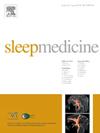Effects of one-night partial sleep deprivation on perivascular space volume fraction: Findings from the Stockholm Sleepy Brain Study
IF 3.8
2区 医学
Q1 CLINICAL NEUROLOGY
引用次数: 0
Abstract
Increased waste clearance in the brain is thought to occur most readily during deep sleep (stage N3). Sleep deprivation disrupts time spent in deeper sleep stages, fragmenting the clearance process. Here, we have utilized the publicly available Stockholm Sleepy Brain Study to investigate whether various sleep-related measures are associated with changes in perivascular space (PVS) volume fraction following a late-night short-sleep experiment. The study sample consisted of 60 participants divided into old (65–75 years) and young (20–30 years) age groups. We found that partial sleep deprivation was not significantly associated with major PVS changes. In our centrum semiovale models, we observed an interaction between percentage of total sleep time spent in N3 and sleep deprivation status on PVS volume fraction. In our basal ganglia models, we saw an interaction between N2 (both percentage of total sleep time and absolute time in minutes) and sleep deprivation status. However, the significance of these findings did not survive multiple comparisons corrections. This work highlights the need for future longitudinal studies of PVS and sleep, allowing for quantification of within-subject morphological changes occurring in PVS due to patterns of poor sleep. Our findings here provide insight on the impact that a single night of late-night short-sleep has on the perivascular waste clearance system.
一晚部分睡眠剥夺对血管周围空间体积分数的影响:来自斯德哥尔摩嗜睡脑研究的发现
大脑中废物清除的增加被认为在深度睡眠(N3阶段)时最容易发生。睡眠不足扰乱了深度睡眠阶段的时间,打乱了清除过程。在这里,我们利用公开的斯德哥尔摩睡眠脑研究来调查各种睡眠相关措施是否与深夜短睡眠实验后血管周围空间(PVS)体积分数的变化有关。研究样本由60名参与者组成,分为老年人(65-75岁)和年轻人(20-30岁)两组。我们发现,部分睡眠剥夺与PVS的重大变化没有显著关联。在我们的中心半值模型中,我们观察到N3总睡眠时间百分比与睡眠剥夺状态对PVS体积分数的相互作用。在我们的基底神经节模型中,我们看到N2(总睡眠时间和绝对睡眠时间的百分比,以分钟为单位)和睡眠剥夺状态之间的相互作用。然而,这些发现的意义并没有经受住多次比较修正。这项工作强调了未来对PVS和睡眠进行纵向研究的必要性,允许量化由于睡眠不良模式导致的PVS的受试者内部形态学变化。我们的研究结果提供了一个晚上的深夜短睡眠对血管周围废物清除系统的影响。
本文章由计算机程序翻译,如有差异,请以英文原文为准。
求助全文
约1分钟内获得全文
求助全文
来源期刊

Sleep medicine
医学-临床神经学
CiteScore
8.40
自引率
6.20%
发文量
1060
审稿时长
49 days
期刊介绍:
Sleep Medicine aims to be a journal no one involved in clinical sleep medicine can do without.
A journal primarily focussing on the human aspects of sleep, integrating the various disciplines that are involved in sleep medicine: neurology, clinical neurophysiology, internal medicine (particularly pulmonology and cardiology), psychology, psychiatry, sleep technology, pediatrics, neurosurgery, otorhinolaryngology, and dentistry.
The journal publishes the following types of articles: Reviews (also intended as a way to bridge the gap between basic sleep research and clinical relevance); Original Research Articles; Full-length articles; Brief communications; Controversies; Case reports; Letters to the Editor; Journal search and commentaries; Book reviews; Meeting announcements; Listing of relevant organisations plus web sites.
 求助内容:
求助内容: 应助结果提醒方式:
应助结果提醒方式:


